新目标八年级下英语第四单元教案(2014版)
- 格式:doc
- 大小:62.00 KB
- 文档页数:8
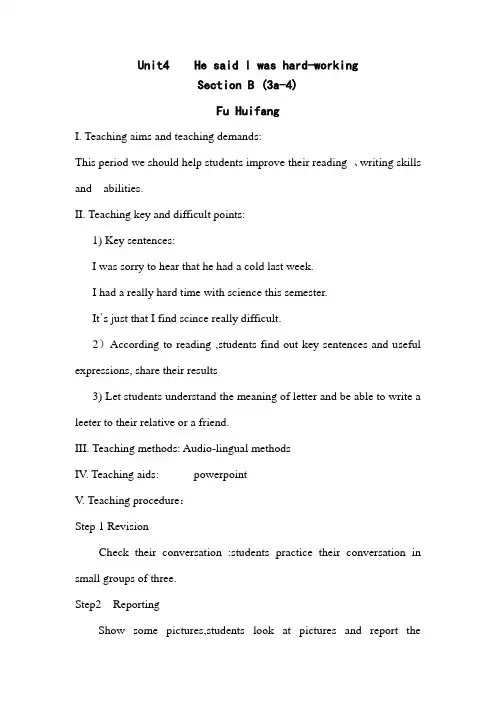
Unit4 He said I was hard-workingSection B (3a-4)Fu HuifangI. Teaching aims and teaching demands:This period we should help students improve their reading 、writing skills and abilities.II. Teaching key and difficult points:1) Key sentences:I was sorry to hear that he had a cold last week.I had a really hard time with science this semester.It`s just that I find scince really difficult.2)According to reading ,students find out key sentences and useful expressions, share their results3) Let students understand the meaning of letter and be able to write a leeter to their relative or a friend.III. Teaching methods: Audio-lingual methodsIV. Teaching aids: powerpointV. Teaching procedure:Step 1 RevisionCheck their conversation :students practice their conversation in small groups of three.Step2 ReportingShow some pictures,students look at pictures and report thesentences to reported speech.Step3 Activity1)play the chain gameExample :A :I am hard-working.B: He said he was hard-working.I like English.C: she said she liked English…..2)Pairwork: students according to their report cards ask andanswer in pair like this:A : what did you math teacher say?B : He said L was a hard-working student..3) Ask and answerAsk students to look at the Scott`sreport card,then answer teacher`s question.Step4 Learning1 . Ask ss to read the letter quickly then answer two questions:1)who is the letter to?2)How did alan do in end-of –year semester?2 .Read it again then find out the important points, students completein small groups.Hope to do …,be in good health, be sorry to do …,have a hard /easy time with ..,disappointing result, find…difficult, send their loveStep 6 homework1)complete 3b,pretend to be scott and write aletter to a relative or a friend.2)Make some sentences using the phrases.Feedback: 本堂课以学生为主体,以活动为主线,让学生充分参与课堂学习,课堂气氛活跃,学生参与面广。
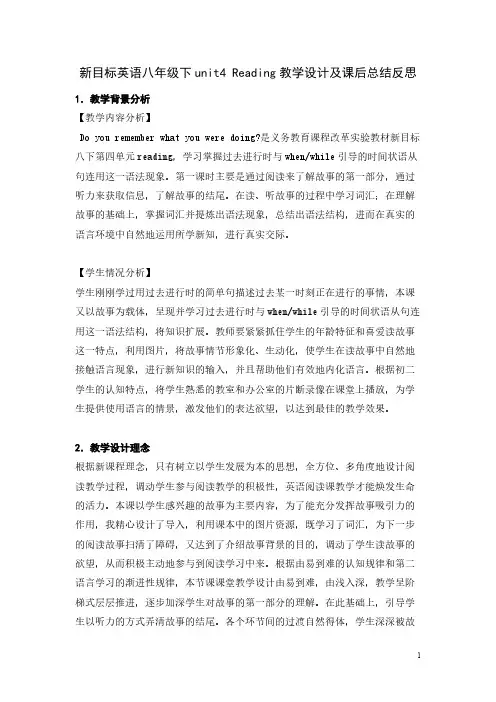
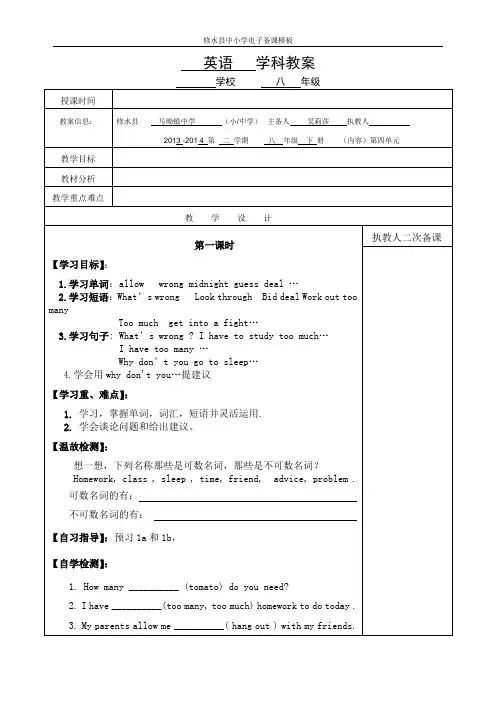

一、教学内容及分析本单元的教材设置从谈论电视剧剧情开始,以对话的形式引出直接引语和间接引语的应用及转换。
通过谈论和学生年龄相仿的电视剧人物,把枯燥的语法知识学习融入情境对话之中,学习如何用英语转述他人的话,学习内容贴近生活,学生学习兴趣高涨。
教学内容安排采用听、说读写结合的方法,让学生在听力、口语阅读、写作练习中,学习新的语法知识,形成正确的语言习惯,提高英语运用能力.二、学习者特征分析: 学生已经学习了一般现在时,一般过去时,现在进行时,过去进行时等时态,能够进行各种时态之间的转换,同时,学生对各种时态的陈述语气也知道怎么变化,因此在学习本单元就容易的多了。
三、单元整体目标分四、重点、难点本单元的教学重点是让学生学会何用英语转述他人的语,了解直接引语、间接引语,学会直接引语转换为间接引语。
本单元的教学难点是把直接引语转换间接引语的转换中,注意动词的时态变化和人称代词的变化,并能口头、笔头上正确运用英语转述他人的观点。
六、课时及教学内容安排教学内容课时安排教法选择教学评价period 1ppt通过让学生转述检查是否掌握,注重过程评价period 2tbl,mit,通过转述电视剧的情景和听力训练,进行过程评价period 3stereo通过转述成绩单正确对待老师的评价period 4tbl通过写作训练学会书面表达与同学互通情感readingperiod 5pre—readingpost--readingppt通过渗透阅读策略和情感态度,进行过程评价教学内容课时period 1教学对象八年级学生提供者一、教材内容分析二、教学目标(知识,能力,情感态度、价值观)知识目标能力目标能将直接引语是陈述句,一般疑问句,特殊疑问句和祈使句,正确的转述为间接引语,同时注意直接引语是客观真理的情况,特别注意指示代词,人称代词等的变化。
情感目标当你转述别人的话时,一定要转述清楚,以免引起误解。
三、重点难点四、教法选择、学法指导本节课,主要是一节语法课,又是第一课时,因此主要采用讲授法,练习法来讲解和巩固语法。

学校学科中畦中学编写时间2014.04.07 编写人年刚课题Unit 4 Why don’t you talk to your parents(SectionA1a——1c)教学媒体多媒体教学教学目标知识技能1. Study new sentences.2. Let them make conversations and act them.过程方法Topic centre teaching approachListening and speaking method; Discussing method;Pair-work,Task-Based Learning method.情感态度1.They can talk about problems and give advice.2.They study how to relax.教学重点1.What's the matter with sb?2.why don't you do? = why not do ?教学难点How to make sentences use new knowledge.教学内容及教师活动学生活动提升拓展反思Step 1Leading:Good morningNice to meet you ! Introduce myself and communicate with students. Eg:1.Can you play computer games on weekends?2.Can you play basketball after school?3.Can you make a friend with this boy or girl?Step 2 Teaching new lesson 1、Study some new words: allow,wrong,midnight,look through,guess,deal, big deal,work out2.Lead students to talk about some problems around them.4.Give some advice and let students match them Good morningNice to meet you ,too!Talk about these questions.1.Let them read some wordsfirst.2.Let them again3.Check some wordsThey can discuss each otherand answer questions.Eg:·study too much·don’t allow me to hang outwith my friends·feel lonely...Talk about how to work outif you have these problems,Introduce myselfand make friendswith themLet them pay moreattention to myclassIt’s important forthem to studysome words.According to theirexperience,theycan say someproblems and givesome advice5.Pair-work(1).Look at the conversation and review some sentences (2).Let them makeconversations6.Practice listening(1).Teach them how to do it(2).Play the tape twice(3).Check and play again 8.SummaryStep 4 Reflectionand look at the screen toremember some adviceEg:What's the matter with sb?What's wrong with sb?What's the trouble with sb?What's up?Eg:why don't you do?=why notdo ?为什么不做某事Let's do...让我们做...Shall we do...?我们做...好吗?How/What about doing... ?做...怎么样?Would you like to do... ?你愿意做...吗?You'd better (not) do .你最好(不)做...I think you need to do ...我认为你需要做...They make conversations usethese sentences and act infront of class.They listen to the tapecarefully and check theanswers with teacher,thenread the tapescripts.Review somesentences whichwe have learnedand use thesesentences to makeConversations.Improving theirlistening skills Blackboard DesigningUnit 4 Why don’t you talk to your parents?Advice:Eg:A: What’s wrong?B: I’m so sad because my parents don’t allow me to hang out with my friends. A: Why don’t you talk to them?。
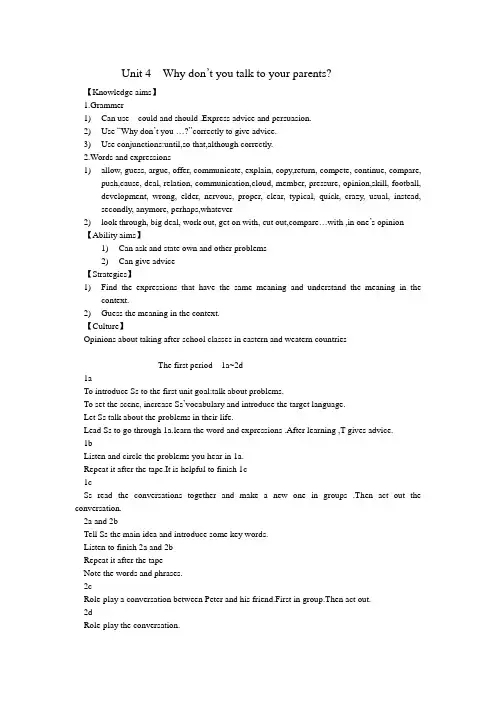
Unit 4 Why don’t you talk to your parents?【Knowledge aims】1.Grammer1)Can use could and should .Express advice and persuasion.2)Use “Why don’t you …?”correctly to give advice.3)Use conjunctions:until,so that,although correctly.2.Words and expressions1)allow, guess, argue, offer, communicate, explain, copy,return, compete, continue, compare,push,cause, deal, relation, communication,cloud, member, pressure, opinion,skill, football, development, wrong, elder, nervous, proper, clear, typical, quick, crazy, usual, instead, secondly, anymore, perhaps,whatever2)look through, big deal, work out, get on with, cut out,compare…with ,in one’s opinion 【Ability aims】1)Can ask and state own and other problems2)Can give advice【Strategies】1)Find the expressions that have the same meaning and understand the meaning in thecontext.2)Guess the meaning in the context.【Culture】Opinions about taking after-school classes in eastern and weatern countriesThe first period 1a~2d1aTo introduce Ss to the first unit goal:talk about problems.To set the scene, increase Ss’vocabulary and introduce the target language.Let Ss talk about the problems in their life.Lead Ss to go through 1a.learn the word and expressions .After learning ,T gives advice.1bListen and circle the problems you hear in 1a.Repeat it after the tape.It is helpful to finish 1c1cSs read the conversations together and make a new one in groups .Then act out the conversation.2a and 2bTell Ss the main idea and introduce some key words.Listen to finish 2a and 2bRepeat it after the tapeNote the words and phrases.2cRole-play a conversation between Peter and his friend.First in group.Then act out.2dRole-play the conversation.First repeat after the tape and underline the words and expressions they don’t know.T explain them to Ss.Then practice and act out the conversation.【Homework】Remember the new words and expressions .prepare the performance for tomorrow.The second period 3a~3cStep1 Revision1. Role play the conversation in 2d2. Talk about the problems and give adviceStep2 Presentation1.Tell Ss what we learned in this unit.Ask them what problems they have in their family andhow they solve them.When there are some problems at home, what do you do as a kid?2.Ask Ss to look at the picture and talk about it .T can give some key words during this step.Forexample,fight a lot,get on with.3.Introduce the article is a letter. Pay attention to the style. And we can get what kind ofinformation from the style.4.Give questions and ask Ss to read and find out the answer.Ss must have enough time to do it.So T is patient to wait for them to find the keys.5.Ask different students to ask and answer the problems and advice.It can be made into somesmall conversations.A:I can’t get on well with my family.What should I do ?B: You should talk about these feelings with his family.6.T play the tape and ask Ss to repeat. When they read, they should underline the new wordsand expressions they don’t know.7.T explain the words and expressions to Ss. Practice them with Ss8.Read and translate the two letters in group. T give help if they need.Step3.DiscussionAsk Ss if they agree /disagree with his advice and why.Step4.Practice3c Which words or phrases in the letters have the same or similar meanings as the following? Write a sentence using each word or phrase.Because my Ss have poor English, it’s better to lead Ss to do it together. Then T write Ss’ answer on the Bb.Step5.HomeworkRewrite the two letter in a short passage.Try to recite the letters.Remember the words and phrases and T check them in class.The third period Grammar Focus~SectionB1eStep1 Revision1.check the words and the expressions on Page 27.2.Encourage Ss to recite or retell the article.Step2 Presentation and practice1,Grammar focusSs read it and translate it in group.T gives help when they work in group.Then T can have a checkabout it.2.4aExpain the use of although, so that and until.Prompt Ss to suggest what these words mean and what they are used for.T can help Ss to make sentences with these words.◆Although is used to join wro parts of a sentence and it shows a contrast between the ideas inthe two parts.◆So that is used to introduce a reason for what is stated in the earlier part of a sentence.◆Until is used to show that an action continues up to a certain time and stops at that time,4b.Tell Ss some problems and ask them what advice they can give.It’s better to write down Ss’answer on the Bb.4cT show these problems to students and discuss them together how to solve the problems. Sometimes Ss can give some perfect responses.Rmind Ss to use the target language to talk about problems and give advice.Section B1a and 1bAsk Ss how to lower stress .Make a list of activities on the Bb. T also can make a survey about the activities in 1a.1cLead Ss to look through the sentences .read and translate them to make sure they understand their meaning .At the same time Ss can get a main idea about the listening material.T can make it a small conversartion about each stress.Listen to check the problems.1dBefore listening , T can ask Ss to make a guess to fill in the blanks by using the contextual clues. After listening, Ss repeat the conversation.1eSs practice speaking the target language by talking about the problems and advice.Step 3 HomeworkMemorize the Grammar FocusTalk about the stress and the way to solve it.Write it down as a composition.The fourth period 2a~2bStep 1 RevisionCheck the words and the phrases.Talk about the problems and give advice.Step 2.Presentation2aGo through the activities and check the ones the Ss do2b1)Ss scan the intructions and the two questions in 2b and predict the main idea to make sure thepurpose of the first reading.2)Ss read the text and say the main idea. If Ss have difficuly, T can provide some pharses for Ssto choose, Then let Ss express the main idea by using the whole sentences3)Ask Ss to read the text carefully. Find the points they can’t understand.Exam skills, so that, in order to , compete, typical, on most days after school, football training, cut out, the tired children don’t get home until after 7:00pm.,have a quick dinner, It’s time for homework,continue, compare…with…, crazy, push their kids hard, development, cause a lot of stress, even.T explain the keys to Ss and practice them with Ss.4)Ss repeat the text after the tape.Step3 HomeworkRetell the storyThe fifth period 2c~self checkStep1.RevesionRetell the textStep 2.Presentation and practice1)Read the passage again and find the words that have the same meaning as the explanation.Sscan do it with T.2)Read it again anf answer the questions in 2b and 2d.T can provide some other questions tocheck Ss understanding.3)Divide Ss into some groups and discuss the questions in 2e.They try to use the targetlanguage in the conversation.T can write the target language on the Bb so that Ss can use them freely.3a~3b1)Read the instruction and parents’ opinion.Know about the purpose of the activity.2)Discuss in group and report to the class.3)Lead Ss to write the composition. Before writing, T lead them to revise the words andphrases about the topic. Ask some students to read their work.Self check1)It is used to check if Ss can use the conjunctions well.First, do them individually, then checkthe answer.2)Ss exchange their ideas and report their ideas.Step 3 HomeworkWrite a composition about 3b.。
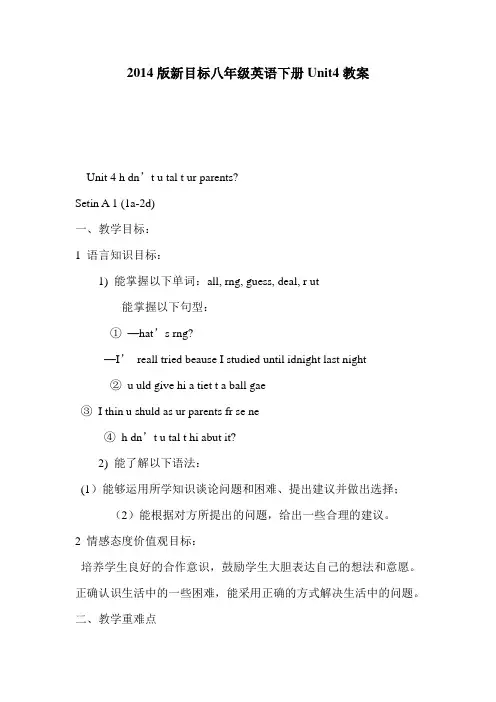
2014版新目标八年级英语下册Unit4教案Unit 4 h dn’t u tal t ur parents?Setin A 1 (1a-2d)一、教学目标:1 语言知识目标:1) 能掌握以下单词:all, rng, guess, deal, r ut能掌握以下句型:①—hat’s rng?—I’reall tried beause I studied until idnight last night②u uld give hi a tiet t a ball gae③I thin u shuld as ur parents fr se ne④h dn’t u tal t hi abut it?2) 能了解以下语法:(1)能够运用所学知识谈论问题和困难、提出建议并做出选择;(2)能根据对方所提出的问题,给出一些合理的建议。
2 情感态度价值观目标:培养学生良好的合作意识,鼓励学生大胆表达自己的想法和意愿。
正确认识生活中的一些困难,能采用正确的方式解决生活中的问题。
二、教学重难点1 教学重点:1) Tal abut the prbles2) Learn the ne language pints2 教学难点:能根据对方所提出的问题,给出一些合理的建议。
学会表达建议的一些方式。
三、教学过程Step 1 aring up1 导入学生们平时在学校和生活中存在的问题。
T: hat’s the atter/ hat’s rng?S: He has t uh her t dT: D he lie t d it?S1:N, he desn’t Beause he desn’t have an free tie t d things he lies …Step 2 Taling1 L at these prbles D u thin the are serius r nt? Ss disuss ith their partners and give se advie①I have t stud t uh s I dn’t get enugh sleep②I have t uh her s I dn’t have an free tie t d things I lie③parents dn’t all e t hang ut ith friends④I have t an after-shl lasses⑤I gt int a fight ith best friendStep 3 Listening1 T: Tell Ss t read the sentenes in 1a again ae sure the n the eaning f the sentenes2 Pla the rerding fr the Ss t listen and irle the prbles u hear in 1a3 Pla the rerding again he the ansers ith the SsStep 4 Pair r1 Let Ss read the nversatin in the bx2 Use the infratin in 1a t ae ther nversatins3 Let se pairs at ut their nversatinseg A: hat’s rng?B: I’reall tied beause I studied until idnight last nightA: h dn’t u g t sleep earlier this evening?4 Language pints1) all v 允许;准许all sb (nt)t d sth (不)允许某人做某事eg parents dn’t all e t sta up late 我父母不允许我熬夜。
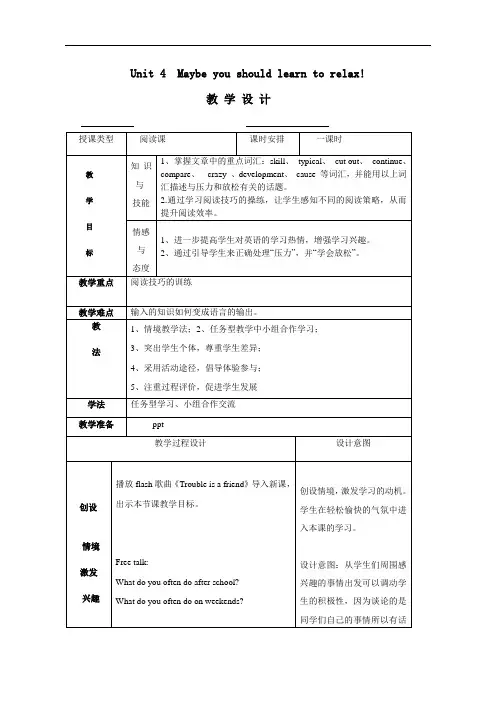
Unit 4 Maybe you should learn to relax!教学设计授课类型阅读课课时安排一课时教学目标知识与技能1、掌握文章中的重点词汇:skill、typical、cut out、continue、compare、crazy 、development、cause 等词汇,并能用以上词汇描述与压力和放松有关的话题。
2.通过学习阅读技巧的操练,让学生感知不同的阅读策略,从而提升阅读效率。
情感与态度1、进一步提高学生对英语的学习热情,增强学习兴趣。
2、通过引导学生来正确处理“压力”,并“学会放松”。
教学重点阅读技巧的训练教学难点输入的知识如何变成语言的输出。
教法1、情境教学法;2、任务型教学中小组合作学习;3、突出学生个体,尊重学生差异;4、采用活动途径,倡导体验参与;5、注重过程评价,促进学生发展学法任务型学习、小组合作交流教学准备ppt教学过程设计设计意图创设情境激发兴趣播放flash歌曲《Trouble is a friend》导入新课,出示本节课教学目标。
Free talk:What do you often do after school?What do you often do on weekends?创设情境,激发学习的动机。
学生在轻松愉快的气氛中进入本课的学习。
设计意图:从学生们周围感兴趣的事情出发可以调动学生的积极性,因为谈论的是同学们自己的事情所以有话可说,有事可做,学生的参与性高,课堂效果较好。
快速阅读,寻找主旨呈现单词,重点掌握1、Fast reading :Get the main idea of each paragraph accordingto the topic sentence.(1)、Life for Cathy Taylor’s three children isvery busy.(2)、Doctors say too much pressure is not goodfor a child’s development.(3)、Chinese children are busier on weekends thanweekdays these days.(4)、Linda Miller knows all about such stress.2、出示单词:skill typical cutout continuecompare crazy cause development让学生理解意思并做句子,大声读单词。
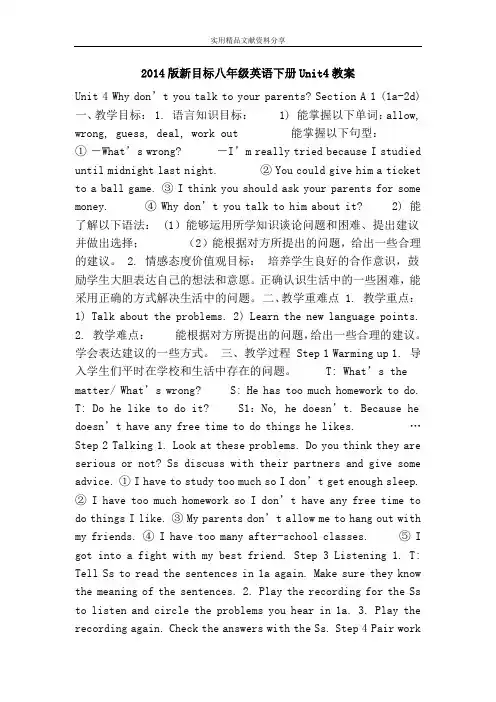
2014版新目标八年级英语下册Unit4教案Unit 4 Why don’t you talk to your parents? Section A 1 (1a-2d) 一、教学目标: 1. 语言知识目标:1) 能掌握以下单词:allow, wrong, guess, deal, work out 能掌握以下句型:① ―What’s wrong? ―I’m really tried because I studied until midnight last night. ② You could give him a ticket to a ball game. ③ I think you should ask your parents for some money. ④ Why don’t you talk to him about it? 2) 能了解以下语法: (1)能够运用所学知识谈论问题和困难、提出建议并做出选择;(2)能根据对方所提出的问题,给出一些合理的建议。
2. 情感态度价值观目标:培养学生良好的合作意识,鼓励学生大胆表达自己的想法和意愿。
正确认识生活中的一些困难,能采用正确的方式解决生活中的问题。
二、教学重难点 1. 教学重点:1) Talk about the problems. 2) Learn the new language points.2. 教学难点:能根据对方所提出的问题,给出一些合理的建议。
学会表达建议的一些方式。
三、教学过程 Step 1 Warming up 1. 导入学生们平时在学校和生活中存在的问题。
T: What’s the matter/ What’s wrong? S: He has too much homework to do. T: Do he like to do it? S1:No, he doesn’t. Because he doesn’t have any free time to do things he likes. … Step 2 Talking 1. Look at these problems. Do you think they are serious or not? Ss discuss with their partners and give some advice. ① I have to study too much so I don’t get enough sleep.② I have too much homework so I don’t have any free time to do things I like. ③ My parents don’t allow me to hang out with my friends. ④ I have too many after-school classes. ⑤ I got into a fight with my best friend. Step 3 Listening 1. T: Tell Ss to read the sentences in 1a again. Make sure they know the meaning of the sentences. 2. Play the recording for the Ss to listen and circle the problems you hear in 1a. 3. Play the recording again. Check the answers with the Ss. Step 4 Pair work1. Let Ss read the conversation in the box.2. Use the information in 1a to make other conversations.3. Let some pairs act out their conversations. e.g. A: What’s wrong? B: I’m really tied because I studied until midn ight last night. A: Why don’t you go to sleep earlier this evening?4. Language points 1) allow v. 允许;准许allow sb. (not)to do sth. (不)允许某人做某事 e.g. My parents don’t allow me to stay up late. 我父母不允许我熬夜。
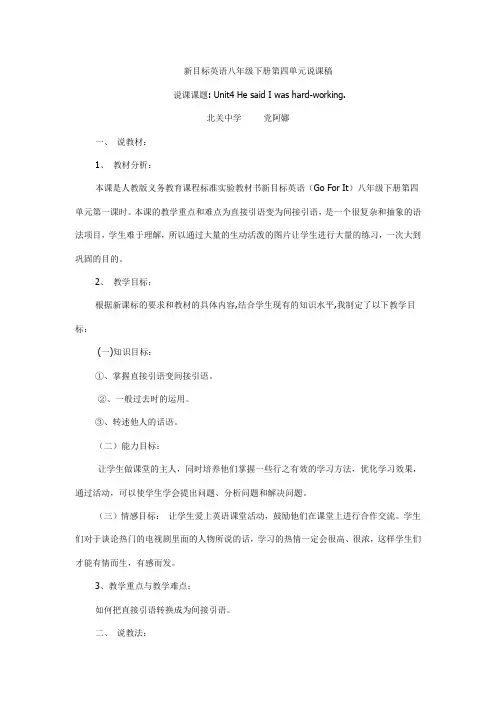
新目标英语八年级下册第四单元说课稿说课课题: Unit4 He said I was hard-working.北关中学党阿娜一、说教材:1、教材分析:本课是人教版义务教育课程标准实验教材书新目标英语(Go For It)八年级下册第四单元第一课时。
本课的教学重点和难点为直接引语变为间接引语,是一个很复杂和抽象的语法项目,学生难于理解,所以通过大量的生动活泼的图片让学生进行大量的练习,一次大到巩固的目的。
2、教学目标:根据新课标的要求和教材的具体内容,结合学生现有的知识水平,我制定了以下教学目标:(一)知识目标:①、掌握直接引语变间接引语。
②、一般过去时的运用。
③、转述他人的话语。
(二)能力目标:让学生做课堂的主人,同时培养他们掌握一些行之有效的学习方法,优化学习效果,通过活动,可以使学生学会提出问题、分析问题和解决问题。
(三)情感目标:让学生爱上英语课堂活动,鼓励他们在课堂上进行合作交流。
学生们对于谈论热门的电视剧里面的人物所说的话,学习的热情一定会很高、很浓,这样学生们才能有情而生,有感而发。
3、教学重点与教学难点:如何把直接引语转换成为间接引语。
二、说教法:1、任务型教学法:给学生提出任务,让学生在任务中学会如何转换他人的话语,强化所学的知识。
2、情景教学法:创造足够的交际环境剌激学生的视听能力,使他们能够更好的理解直接引语与间接引语这一语法项目,以培养他们的听、说能力。
3、讲解法:通过讲解,学生们可以学习到其中的新的语法项目:间接引语。
三、说学法:遵循“教为主导,学为主体,练为主线”的教育思想。
1、指导学生以小组为单位进行讨论,随着老师的问题,学生自学教材,主动思考,培养学生的分析和解决问题的能力。
2、指导学生发现并掌握知识内在的联系,通过活动,让学生在完成任务的过程中学会使用间接引语,可以增加学生们参与的兴趣。
3、通过观察、讨论、分析去发现知识,逐渐培养学生自主学习的习惯和能力,通过课堂上的交流,体验知识获得的过程,体会同学间合作的魅力,尝到探究性学习的乐趣。
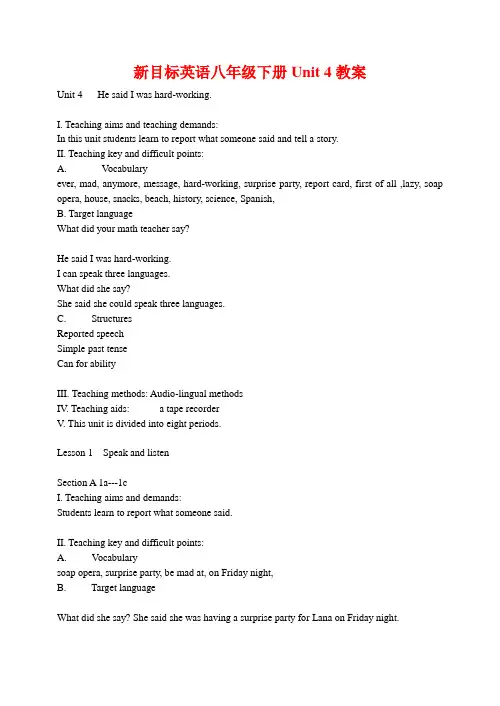
新目标英语八年级下册Unit 4教案Unit 4 He said I was hard-working.I. Teaching aims and teaching demands:In this unit students learn to report what someone said and tell a story.II. Teaching key and difficult points:A. V ocabularyever, mad, anymore, message, hard-working, surprise party, report card, first of all ,lazy, soap opera, house, snacks, beach, history, science, Spanish,B. Target languageWhat did your math teacher say?He said I was hard-working.I can speak three languages.What did she say?She said she could speak three languages.C. StructuresReported speechSimple past tenseCan for abilityIII. Teaching methods: Audio-lingual methodsIV. Teaching aids: a tape recorderV. This unit is divided into eight periods.Lesson 1 Speak and listenSection A 1a---1cI. Teaching aims and demands:Students learn to report what someone said.II. Teaching key and difficult points:A. V ocabularysoap opera, surprise party, be mad at, on Friday night,B. Target languageWhat did she say? She said she was having a surprise party for Lana on Friday night.Did you ever watch soap opera?What are some things happened on soap opera?III. Teaching methods: Audio-lingual methodsIV. Teaching aids: a tape recorderV. Teaching procedureActivity 1. RevisionTask 1. DictationTask 2. Ask and answer.Questions about the past progressive.Activity 2. PresentationThis activity introduces some new vocabulary and provide oral practice using the target language.Task 1 . Ask four students to stand in front of the class, and the teacher asks them the following questions as a reporter.1. What are you going to do when you grow up?2. What are you going to do next week?3. What are going to do after school?The students will give different answers, then ask a good student to report what they said.I am going to e a doctor.What did she say?----------She said she was going to be a doctor.I am going to have a party on Friday night.What did he say?-------He said he was going to have a party on Friday night.I am going to do my homework.What did she say ?------ She said she was going to do her homework.I am going home after school.What did she say?-----She said she was going home after school.Say In this unit we are going to learn to use words like to report what someone said.Task 2. Read the instructions. Then ask a student to read the four questions. And write the words on the Bb. Explain what soap opera is.Task 3. Ask the students to Look at the pictures, point out the TV screens in the picture. Ask one girl to read what Marcia said.What did Marcia say? She said She said she was having a surprise party for Lana on Friday night. Repeat the other pictures in the same way.Activity3. Listen and number the pictures in activity 1a.Task 1. Play the recording the first time. Students only listen.Task 2. Play the recording a second time. Students number the pictures. Then check the answers.Activity 4. PairworkAsk the students to ask and answer about what the people in the soap opera said.Homework1. Make up your own conversations.2. Write down the sentences in 1a.Lesson 2 Listen and speakSection A 2a---Grammar FocusI. Teaching aims and demands :Students learn to report what someone said.II. Teaching key and difficult points:A. V ocabularya surprise party, be mad at, not… anymore, bring …to , happen (on), Direct Speech, Indirect Speech.B. Target languageBen told Lana that Marcia was going to have a surprise party for her.She said she was mad at Marcia.He told me he would call me tomorrow / the next day.She said she could speak three languages.III. Teaching methods: Audio-lingual methods and PPPIV. Teaching aids: a tape recorderV.Teaching procedureActivity 1. RevisionTask1. Check the homework. Ask and answer.I am a student.What did he say?-----He said he was a student.I can swim.What did she say ?------She said she could swim.I will ring you up tomorrow.What did she say?She told me she would ring me up.Activity 2. Listening and circling .Task1.Read the instructions. Learn the key vocabulary.Task2.Point to the five sentences and ask different students to read them to the class. Then say:You will hear a conversation between two people who are talking about a soap opera on TV.Circle True or false after each statement.Play the recording twice and students circle their answers. Then check the answers.Activity 3.ListeningTask 1. Read the instructions.Task 2. Play the recording again and check the answers.Activity 4. GroupworkTask 1.Read the instructions for the activity.Task 2. Point to the pictures in activity 2b.Ask the students to use the words and pictures as they have their conversations.Task 3. Have the students work in pairs.Task 4. Check the answers by calling on different pairs to say a conversation to the class. Activity 5. Grammar FocusReview the grammar box.ask the students to say the statements.Pay attention to the following:Direct speech Indirect speecham, is , am having, go, will, can was , was having, would , could, wenta present situation a past situationWhen you report what someone said, you use words that talk about the past.Homework1. Review the conversation and the vocabulary.2. Write the sentences in grammar focus.。
新目标英语八年级(下)Unit 4 Reading She Said HelpingOthers Changed Her Life教学设计1. 八年级学生经过一年多的学习,有了一定的英语基础知识和听说能力,正逐渐向读、写过渡。
同时,学生对英语学习还保持着一定的兴趣,有了初步的自主、合作、探究、实践的能力。
2. 阅读理解能力是初中阶段英语教学的一项重要能力。
在实际教学中,八年级学生在阅读理解方面仍然存在一定困难,如阅读习惯不良等。
二、教材分析1. She Said Helping Others Changed Her Life. 是该单元最后一个课时的教学内容。
教材从八年级下册开始基本每单元最后都有一篇阅读文,这些文章篇幅长,生词多,读前、读中、读后的任务多。
鉴于学生的实际情况及教材的特点,考虑到学生对长篇阅读的畏难情绪以及他们在课堂上可能出现的一些反应,我大胆构思了整个教学过程,构建“以生为本”的互动式阅读课堂,并根据需要整合了运用多种教学方法,让学生在互动中享受阅读,在课堂上彰显活力。
2. 本节课所有活动项目的设计,一方面消除学生的不良情绪,调动学生主动参与的积极性,体验阅读的乐趣;另一方面也训练学生的思维,提升情感,养成一定的学习策略,以利于今后各种英语教学活动的顺利开展。
三、教学目标1. Knowledge objectivesTo master the words and expressions.To get familiar with the topic and use the sentences about helping others.To use “Direct Speech and Reported Speech”.2. Ability objectivesTo find out the information and get the general idea of the text.To infer the meaning of the word they don’t know from the context.3. Affective objectivesStudents are to realize the importance of helping others and they are encouraged to help others. Students’ team spirit will be improved by completing a certain task together.By understanding the life in rural areas, students are to realize how happy they are.四、教学策略1.《英语课程标准》强调英语教学要从学生的发展需要出发,培养学生综合运用语言的能力。
学生姓名年级八年级授课时间教师姓名课时2小时课题Unit 4. Why don’t you talk to your parents?教学目标熟悉语法:情态动词could, should表建议的用法;从属连词although, so that, until 的用法。
重点学会使用表建议的交际用语。
难点从属连词although, so that, until的用法。
一、语法:1.could是情态动词,意为“可以”,可以用来委婉地提出建议、请求,没有人称和数的变化,后接动词原形。
否定形式为couldn’t. 回答could的一般疑问句时,用can/can’t.You could go out and buy her some medicine.-Could I use your pen?-Yes, you can. Here you are.2.should是情态动词,意为“应该”,可以用于所有人称,表示劝告或建议。
其后跟动词原形,没有人称和数的变化。
否定形式是在should后加not。
You should wait a little longer.He shouldn’t eat too much junk food.3.从属连词although, so that, until的用法。
Although 虽然,尽管,即使引导让步状语从句。
与but不能同时用在一个句子中。
Although the sun is shining, it’snot warm today.So that 以便于引导目的状语从句。
He’s studying hard so that hecan pass the exam.Until 到…时;直到…为止引导时间状语从句。
用在肯定句中意为“直到…为止”;用在否定句中,构成not…until,意为“直到…才”。
I stayed there until he came back.I didn’t leave until he came back.1. I have a bad headache. What I do?A.should B. will C. would D. won’t2. 用could或should填空:(1)- I take the books out of the room?- No, you can’t.(2)You speak English in the English class.(3)you please help me with my Chinese?(4)if you go out at night, you tell your parents.3. I really enjoyed your lecture, there were some parts I didn’t quite understand.A.because B. unless C. although D. after4. Mr. Green speaks very loudly all the people can hear him clearly.A.so that B. because C. when D. until二、词法、句法:Section A1.My parents don’t allow me to hang out with my friends.Allow v. 允许,准许allow sb. to do sth. 允许某人做某事Allow (doing) sth. 允许(做)某事,更能够凸显说话者对不被允许事务的强调意味。
新目标英语八下教案unit 4 第四课时
课题Unit4.HesaidIwashard–working
课时第四课时教、学法情景与创新相结合
教学
目标1.Let’sgooverunit4.understandthenewwordsandexpressions.
2.引导学生复习并掌握本单元的语法及重点句型。
3.通过做题。
能熟练应用直接引语变间接引语
重点
难点变直接引语为间接引语
通案
一、课前测评。
用所给单词的适形式填空。
1、Youare___(suppose)tomeetatthebusstop.
2、Mother___(tell)meshecouldn’tcookdinner.
3、Theoldmankeeps____(exercise),soheisingoodhealth.
4、Hewas___(luck)tobuythelastticketatthelasttime.
二、导入新课。
今天我们来检测一下在本单元中我们所学的内容是否掌握好了。
能否用所给的词说出自己的话。
同时。
你会用疑问句的间接引语了吗?
三、授新课。
Unit4 Period1 教案●教学内容与分析❶教学内容:Section A 1a—1c❷教学目标:Topic: Telling a story.Key words: hard-working, report surprise party . be mad at soap opera Functions: Report what someone said.Structure: Reported speech Simple past tense; Can for abilityLearning Strategies: listening for key words; self- evaluating●教学重点、难点分析:Target language:What did your math teacher says?He said I was hard working.I can speak three languages.What did she say?She said she was having a surprise party.●课前准备教学课件和录音机●教师设计教学步骤建议和说明Step1(Warm-up/Revision)Free talkWhat were you doing at 8:00 last Saturday evening?(I was watching Tv/…)What kind of TV show do you know?Step2 Lead-inGet the students to look at the pictures carefully, make sure most of the students know what is happening in the pictures.大脑风暴,打开学生思维,讨论Do activity 1a. Ask the students to read the questions and talk about them. Maybe the teacher can explain what a soap opera is.A soap oper a is a drama, typically performed as a serial on daytime television or radio, characterized by stock characters and situations sentimentality, and melodrama.What is a soap opera?Do you ever watch soap operas?What are some soap operas you know?What are some things that happen on s oap operas?Show students several soap operas.Step3 PresentationShow some pictures to teach reported speech Simple past tense He said he wanted to be the best student in his class.He said he would try his best to improve his English.The cat told the mouse they were good friends!He told the baby he was going to give him some milk!He said he could give these flowers to his mother !Step4 Listening1b. First Listen to the tape about Young Lives and number the pictures. Check answers.Then listen again. Listen and write T or F for each statement. 1.Ben told Lana that Marcia was going to have a surprise party for her. Tna said she wasn’t mad at Marcia anymore. Tna said that she wouldn’t go to Marcia’s house on Friday night. F4. M arcia called everyone and told them she wasn’t going to soap opera为学习间接宾语做铺垫。
Unit4 why don't you talk to your parents【学习目标]:1.学习单词:allow wrong midnight guess deal…2.学习短语:What's wrong Look through Bid deal Work out too manyToo much get into a fight...3.学习句子:What's wrong ? I have to study too much...I have too many…Why don't you go to sleep...4.学会用why don't you...提建议【学习重、难点]:1.学习,掌握单词,词汇,短语并灵活运用.2.学会谈论问题和给出建议。
【温故检测]:想一想,下列名称那些是可数名词,那些是不可数名词?Homework, class, sleep, time, frie喊advice, problem.可数名词的有:不可数名词的有:[自习指导]:预习la和1b,【自学检测】1. How many_ (tomato) do you need?2. I have— (too many; too much) homework to do today.3. My parents allow me— ( hang out) with my friends.4. I got(介词填空)a fight with my best friend.5. Why don't you— (go) to sleep earlier this evening?【合作交流】:1.听录音,我来完成lbo2. Listening,完成2a,2b.3.重点句子学习:1)你能区别too much,much too, too many吗?请给大家讲讲:2)你会写:‘吮许某人做某事”吗?3)学习,讨论:Be good at二,善于,擅长,在,,,方面做得好。
Be good for,,,对,,,有益处。
Be good to对,,,好(和善)。
Be goodwith,,,与,,,相处的好4)向别人发出邀请,请求,建议,或征求某人的意见的表达方式:(1), Why don't you do something? /Why not do something?“你为什么不做某事呢?”(2), How /what about doing sth.? (about是个介词,可跟名词或动名词)’‘…怎么样?’,e.g.: How/what about the photo album?一个像册怎么样?How about getting her a scarf?买条围巾送给她怎么样?(3),You'd better (not) do something."你最好(不)做某事”(4), Would you like sth ... ?:“你想要某吗”物(5), Let's do sth...?(6). What should I do ... ?( should表示请求、征询对方意见)e.g.: What should I get my dad for his birthday?我该送给爸爸什么作为他的生日礼物呢?【当堂训练】:汉译英:去睡觉擅长闲逛2. Get into a fight4.给某人打电话6.Look through.就划线部分提问1 35二1. We need two apples.2. She needs some milkapples_ we need?milk she need?三.写一写1.你能准确的写出来吗?—,〕—her a book?你为什么不给她本书哪?a scarf—围巾怎么样?2. Why not come over to join us?over to join us?3. How about the sweater?_do you__the sweater?4. What's wrong ?What's?【小结反思】:本节课我学会了提建议的方式有:第二课时((Section A 3a-4c)【学习目标】1.通过阅读这封信,我们学会遇到问题要主动地去和家人,朋友,同学交流。
2.学习文章中出现的重点单词,词组和句型3.培养学生的阅读能力【学习重难点]:1.遇到问题要主动地去和家人,朋友,同学交流2.掌握文中出现的重点单词,词组和句型【温故检测】S1: You look really tired.What's the— ?S2: Why don't you— to sleep earlier.S3: You should talk— them again .S4: Why don't you forget about it you can be friends again?S5: Thanks for yourS6: That's a good【自习指导】小组讨论学习3a,完成Problems,Advice.重点句子学习:1.你能更大家讲讲、ly problem is that Ican't get on with my family.e.g.: How/what about the photo album?一个像册怎么样?How about getting her a scarf?买条围巾送给她怎么样?(3),You'd better (not) do something."你最好(不)做某事”(4), Would you like sth ... ?:“你想要某吗”物(5), Let's do sth...?(6). What should I do ... ?( should表示请求、征询对方意见)e.g.: What should I get my dad for his birthday?我该送给爸爸什么作为他的生日礼物呢?【当堂训练】:汉译英:去睡觉擅长闲逛2. Get into a fight4.给某人打电话6.Look through.就划线部分提问1 35二1. We need two apples.2. She needs some milkapples_ we need?milk she need?三.写一写1.你能准确的写出来吗?—,〕—her a book?你为什么不给她本书哪?a scarf—围巾怎么样?2. Why not come over to join us?over to join us?3. How about the sweater?_do you__the sweater?4. What's wrong ?What's?【小结反思】:本节课我学会了提建议的方式有:第二课时((Section A 3a-4c)【学习目标】1.通过阅读这封信,我们学会遇到问题要主动地去和家人,朋友,同学交流。
2.学习文章中出现的重点单词,词组和句型3.培养学生的阅读能力【学习重难点]:1.遇到问题要主动地去和家人,朋友,同学交流2.掌握文中出现的重点单词,词组和句型【温故检测】S1: You look really tired.What's the— ?S2: Why don't you— to sleep earlier.S3: You should talk— them again .S4: Why don't you forget about it you can be friends again?S5: Thanks for yourS6: That's a good【自习指导】小组讨论学习3a,完成Problems,Advice.重点句子学习:1.你能更大家讲讲、ly problem is that Ican't get on with my family. These days ,most of us feel it hard to get along with our parentsThat's all for my speech.thank you.【小结反思】:本节课我学会了第三课时(Section B la-2a)【学习目标】:掌握本节课的单词,句子:member,pressure-My parents give me a lot of pressure about school.进行听力训练,提高综合听说能力l)刀3).遇到问题要主动地去和家人,朋友,同学交流,学会放松,缓解压力.【学习重、难点】:1)进行听力训练,提高综合听说能力。
1).听力训练温故知新:复习Unit4 Section A Grammar Focus中的句子,看看你能背写下了吗?自主互助学习:和同桌合作完成Unit4 SectionB la,lb听力训练1.认真听录音完成了lc和Id2.再听录音核对答案.3.综合提高:小组分角色朗读听力材料中的对话。
重点语法学习:Until, so that,although引导的状语从句:Until:在带有till或until引导的时间状语从句从句里,如果主句用肯定式,其含义是“一直到……时”,谓语动词只能用延续性动词。
如果主句用否定式,其含义是‘直到……才……,’,‘在……以前不……”,谓语动词可用瞬间动词例如:The young man read till the light went out.Let's wait until the rain stops.We won't start until Bob comeDon't get of until the bus stops.so that:引导目的状语从句so that(为了,以便)例如:We started early so that we could catch the first train.He studies hard so that he could work better in the futureAlthough: although的用法意思相当于though(尽管,虽然),用来引导让步状语从句.它所引导的从句不能与并列连词but, and, so等连用,但可以和yet, still等词连用。
例如:(D Although the book was old, we decided to buy it.尽管这本书很旧,我们还是决定买。